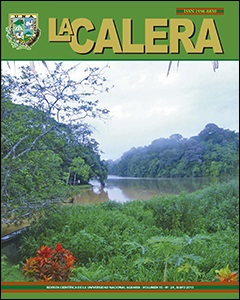Crecimiento, acumulación de biomasa seca y nutrientes en los frutos de café (Coffea arabica L.) variedad Pacas, Masatepe, Nicaragua
DOI:
https://doi.org/10.5377/calera.v15i24.2932Palabras clave:
árboles de sombra, árboles de servicio, leguminosas, curva de crecimiento, elementos esencialesResumen
De abril a diciembre de 2012, en un ensayo ya establecido se realizó un estudio en el cultivo de café variedad pacas, con el objetivo de determinar las curvas de crecimiento, acumulación de biomasa seca y acumulación de nutrientes (N, P, K, Ca y Mg) en los frutos de café uva. El ensayo fue establecido en el año 2000 en el Jardín Botánico hoy conocido como Centro Nacional de Educación y Cooperativismo (CENECCOP), Masatepe, Nicaragua. Se seleccionaron cuatro parcelas grandes con combinación de árboles de sombra maderables y de servicio y una parcela a pleno sol. Los tratamientos en estudio fueron a) Inga laurina y Simaruba glauca, b) Samanea saman y Tabebuia rosea, c) Samanea saman e Inga laurina, d) Tabebuia rosea y Simaruba glauca y e) una parcela a pleno sol. Las parcelas fueron distribuidas en un diseño de bloques completos al Azar (BCA). Las variables evaluadas en los frutos de café fueron diámetro polar, diámetro ecuatorial y peso seco. Los frutos se secaron en el horno a 70 °C y posteriormente se utilizó un molino Foss Tecator Cyclotec para obtener una muestra fina. De la muestra molida de los frutos, en el laboratorio de suelo y agua de la UNA se determinaron las concentraciones de N, P, K, Ca y Mg. Los datos fueron colectados cada 30 días. Para el análisis estadístico se utilizó SAS 9.1. Las curvas de crecimiento del fruto y la acumulación de peso seco se ajustaron a regresiones no lineales simples y dobles exponenciales. Se realizó una correlación entre el diámetro polar y diámetro ecuatorial de los frutos dando un coeficiente de determinación r de 98% (Pr>F= 0.0001). Para el ajuste de la curva de aumento de peso seco se utilizó el modelo Probit normal. El mayor crecimiento de los frutos se dio durante los primeros 90 días y la mayor acumulación de nutrientes se dio entre los 90 y 210 días. La combinación de árboles leguminosos presentó el diámetro polar y ecuatorial más alto. También la acumulación de biomasa seca fue mayor en el tratamiento con sombra de leguminosas.
Revista Científica Vol. 15. Nº 24, p. 6-12 mayo 2015
Descargas
1375

